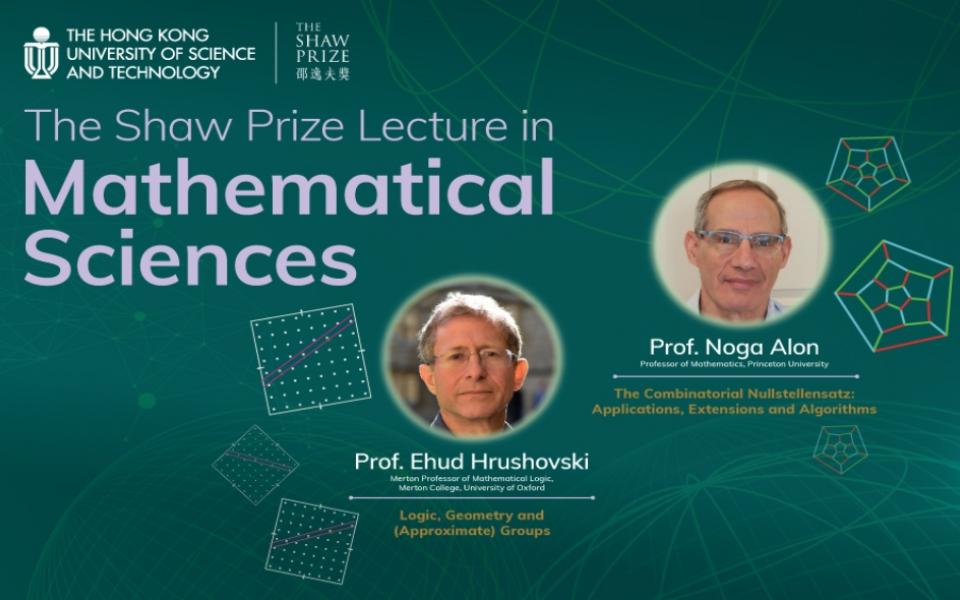The Shaw Prize Lecture in Mathematical Sciences
Supporting the below United Nations Sustainable Development Goals:支持以下聯合國可持續發展目標:支持以下联合国可持续发展目标:
Prof. Ehud Hrushovski
Title: Logic, Geometry and (approximate) groups.
Abstract: I will discuss some points of contact between mathematical logic and geometry, centering on plane geometry, symmetries and approximate symmetries. The talk is intended to be understandable to mathematically oriented high school students, at least in part.
Prof. Noga Alon
Title: The Combinatorial Nullstellensatz: Applications, Extensions and Algorithms
Abstract: The focus of the lecture is a topic to which I devoted much efforts over the years. It is still the subject of some of my present work and of the research of a considerable number of additional researchers. This is the Combinatorial Nullstellensatz, a variant of Hilbert's Nullstellensatz which is one of the foundational results of Algebraic Geometry. This variant found applications in Combinatorics, Graph theory, Additive Number Theory and Combinatorial Geometry. I will describe some of these applications and discuss briefly their intriguing algorithmic aspects.
Noga Alon was born in 1956 in Israel and is currently Professor of Mathematics at Princeton University, USA and Baumritter Professor Emeritus of Mathematics and Computer Science at Tel Aviv University, Israel. He received his Bachelor’s and Master’s degree from Technion–Israel Institute of Technology and Tel Aviv University respectively. He later earned his PhD in Mathematics in 1983 from the Hebrew University of Jerusalem, Israel. He joined Tel Aviv University in 1985 and was successively Senior Lecturer (1985–1986), Associate Professor (1986–1988) and was appointed Full Professor from 1988 until retirement. He had also served as the Head of the School of Mathematical Sciences (1999–2000). He moved to Princeton University in 2018, where he has since held the position of Professor. He is a member of the Israel Academy of Sciences and Humanities and the Academy of Europe. He is also an honorary member of the Hungarian Academy of Sciences.
Ehud Hrushovski was born in 1959 in Israel and is currently Merton Professor of Mathematical Logic, Merton College at the University of Oxford, UK. He obtained his Bachelor’s degree and PhD in Mathematics from the University of California, Berkeley, USA in 1982 and 1986 respectively. He was an Instructor (1987–1988) and Visiting Assistant Professor (1988–1989) at Princeton University, USA. He joined the Massachusetts Institute of Technology (MIT), USA where he was successively Assistant Professor (1988–1991), Associate Professor (1992–1994) and Full Professor (1994). While working at MIT, he also served as an Assistant Professor (1991–1992) and became a Full Professor (1994–2017) at the Hebrew University of Jerusalem, Israel. He moved to the University of Oxford in 2016, where he has been appointed Merton Professor of Mathematical Logic (2016–). He is a member of the Israel Academy of Sciences and Humanities and the American Academy of Arts and Sciences.
The Shaw Prize in Mathematical Sciences 2022 is awarded in equal shares to Noga Alon, Professor of Mathematics at the University of Princeton, USA and Ehud Hrushovski, Merton Professor of Mathematical Logic, University of Oxford, UK for their remarkable contributions to discrete mathematics and model theory with interaction notably with algebraic geometry, topology and computer sciences.
Noga Alon works in the broad area of discrete mathematics. He introduced new methods and achieved fundamental results which entirely shaped the field. Among a long list of visible results with applications, one can extract the following contributions. With Matias and Szegedy he pioneered the area of data stream analysis. With Milman he connected the combinatorial and algebraic properties of expander graphs. With Kleitman he solved the Hadwiger–Debrunner conjecture (1957). In his “combinatorial Nullstellensatz” he formulated in a special case an explicit version of Hilbert’s Nullstellensatz from algebraic geometry which is widely applicable for discrete problems. This led to a proof (1995) of the Dinitz conjecture on Latin squares by Galvin and further generalizations. With Tarsi he bounded the chromatic number of a graph. With Nathanson and Ruzsa he developed an algebraic technique yielding a solution to the Cauchy–Davenport problem in additive number theory. His book with Spencer on probablistic methods became the essential basic manual on probability, combinatorics and beyond.
Ehud Hrushovski works in the broad area of model theory with applications to algebraic-arithmetic geometry and number theory. Among a long list of visible results with applications, one can extract the following contributions. He introduced the group configuration theorem as a vast generalization of Zilber’s and Malcev’s theorems, which became a powerful tool in geometric stability theory and eventually enabled him to solve the Kueker’s conjecture for stable theories. With Pillay he proved a structure theorem on groups which led him to then prove the Mordell–Lang conjecture in algebraic geometry in positive characteristic. This came as a big surprise. He disproved a conjecture by Zilber on strongly minimal sets, introducing a method which became an essential technique for estimating complexity. He wrote with Chatzidakis a theory of difference fields which, he showed later, has striking applications to dynamics in geometry over finite fields, and was for example a key tool to solve the Gieseker conjecture on the structure of D-modules over finite fields. He found a proof of the Manin–Mumford conjecture (Raynaud’s theorem) using his tools ultimately stemming from logic. He gave algorithms to compute Galois groups of linear differential equations. Finally, he developed a theory of integration in valued fields and non-archimedean tame geometry, starting from his work with Kazhdan (2006) and finishing with his work with Loeser (2016).
